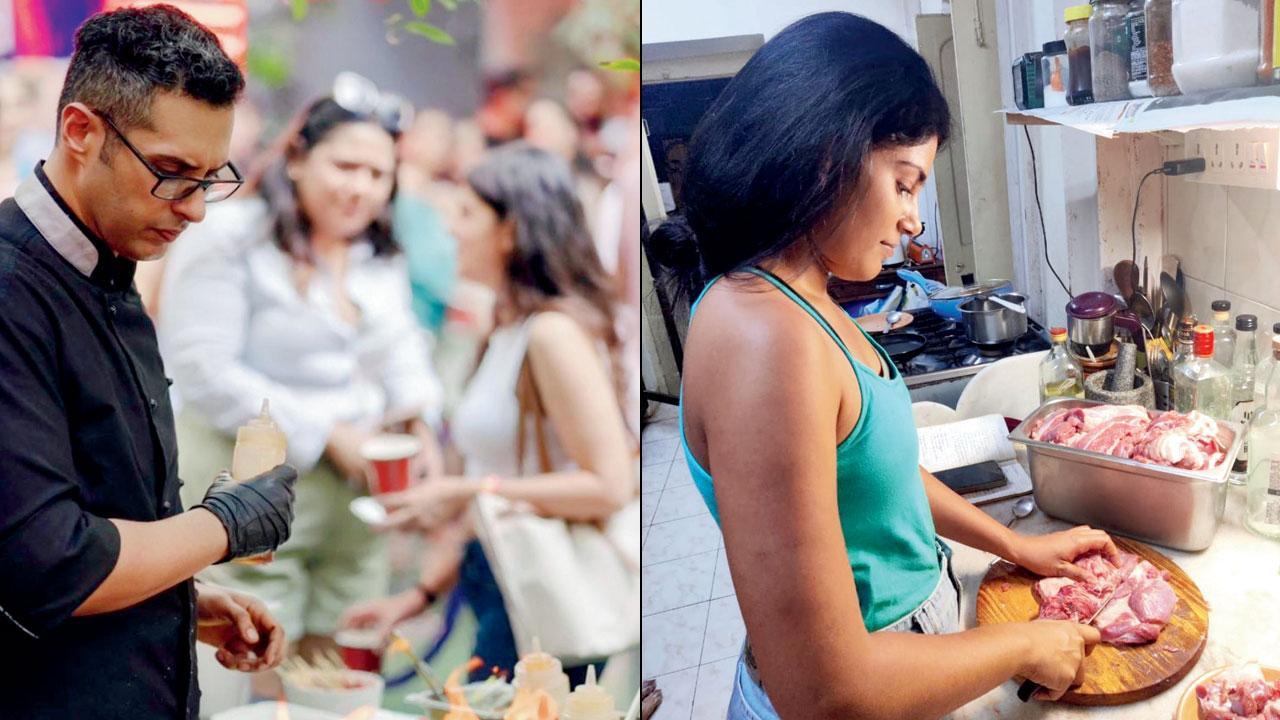Since December 2023, prices of pork have risen or the meat has simply withdrawn from menus. We sniff around the mystery

Chef Delzad Avari at a pop up, grilling a pulled pork burger; (right) Chef Larissa Valladares working on a pork-forward order in her home kitchen
Key Highlights
- It built up over a few months, spiralled out of control quickly last week during Easter
- Chef Delzad Avari noticed an acute shortage in the supply of pork meat
- Speciality shops in Bandra, Borivli, Malad and Navi Mumbai had to turn patrons away
It built up over a few months, spiralled out of control quickly last week during Easter. Chef Delzad Avari noticed an acute shortage in the supply of pork meat, resulting in prices shooting through the roof in a couple of weeks. Speciality shops in Bandra, Borivli, Malad and Navi Mumbai had to turn patrons away, or pack smaller measures than desired.
Those working with the medium say supply has grown scant and unreliable since December 2023. Avari’s supplier told the Cordon Bleu-trained chef that piggeries are not able to keep up with the new demand for cold cuts and pork-based breakfast meats from new gastronomy converts. “The demand for pork has gone significantly high in the last few years, with consumption not limited to sausages, ham, and bacon at breakfast or Chinese dinners,” says the chef behind the home set-up in Mahim, Delz Kitchen. “People are now enjoying smoked meats, homemade bacon, porchetta and more. There was always a significant pork-eating population of Catholics, Parsis, and Punjabis, and I started off by making pulled pork burgers and have seen customers from other communities begin to enjoy pork-based eats. The supply, however, hasn’t been able to catch up.”
ADVERTISEMENT

Anil D’Souza of Joseph Cold Storage in Bandra
So what does it mean for custom chefs like Avari, who specialise in pork dishes and charge a premium for the quality of ingredients used? “The price hike is now eating into our profits,” he complains. “Increasing prices on the menu to accommodate a hike of more than Rs 150 per kilo isn’t a viable option. Besides, for chefs like us who are into pork processing—a time-consuming process that adds cost—justifying premium selling prices becomes a challenge.”
Her supplier gave Larissa Valladares, who runs Incendiary Kitchen in Bandra and specialises in artisanal smoked meats, the inside news: Most old-time piggeries and backyard farms that supply to the city have shut down or reduced production because their next generation isn’t ready to take over the business. They’ve either moved cities or countries in search of bigger fish to fry.
A wave of African swine fever virus six months ago also devastated livestock, claiming thousands of piglets. “At a bulk rate, I used to pay Rs 320 a kilo [before],” she says. “Now, it’s R450 a kilo. Most people buy pork without skin and bone, which retail rates are above Rs 500. The large white Yorkshire and Duroc cross breeds are better, the meat quality is ace.” Unlike Avari, Valladares has been increasing the price on her menu because her customers are aware of the price hike in meat.

Diganta Saikia
“For the longest time, pig farming was an unorganised sector and a misunderstood product,” informs Anil D’zouza of Joseph Cold Storage in Bandra, adding, “India is a big market for pork, and with the increase in awareness, more people are consuming it than before—pork is becoming trendy again. It is good for health and a delicious source of protein. Since production dropped, and festive season reigned, prices rose by Rs 100 [per kilo]. However, production cost is also high because everything—from fuel to labour—has increased. The sector needs help and education, and if local governing bodies encouraged and trained farmers for pig farming, it would address the demand-supply gap.”
Kalina-resident Smita Miranda’s supplier informed her that even the rise in prices of pork feed are responsible for price hike, as well as the increased demand during festive and wedding season. “The supply has been insufficient since December last year, when the first sharp rise was noted,” she says, “While we didn’t alter our Easter menu, we haven’t bought pork as regularly in the last few months. Earlier, it cost R290 a kg for meat with bones, but now it has hiked up to R370.”
According to the survey Consumption of Pork in India 2013-2023, Published by A Minhas, over 292 thousand metric tons of pork were consumed across the country in 2023. The report also states that most pork consumption—almost 70 per cent—is in northeastern states such as Assam and Nagaland. Even though the region ranks high in production, the demand necessitates flow from Haryana, Karnataka, Rajasthan, Madhya Pradesh, and Maharashtra.
A fever in these states makes the maximum city sneeze. Rural food start-ups such as Manxho, that operate from Dibrugarh (Assam), offer smoked meat delicacies from the region. Its co-founder, Diganta Saikia, gave us an insight into the pork industry of the northeast. “Just before COVID-19, pigs in Arunachal Pradesh—and later in other states—caught the African Swine Fever (ASF), a highly infectious haemorrhagic viral disease,” he says. “We lost 50 per cent of our livestock and needed to draw in from other states. Soon, the government banned imports of meat to arrest the spread of the disease. This led to an organised black market and a sharp price hike. Unfortunately some drivers, who came in contact with the virus in infected farms and did not disinfect properly, unwittingly carried ASF to other states outside the North East of India such as in Maharashtra, affecting livestock there."
Addressing the elephant in the room, D’Souza brings up the influence of politics on meat production in the country: “We know how political pushback transpires, with diet choices being questioned and forced upon. Many also think of it as a dirty animal, and hence pig farming is discouraged. All this happens in broad daylight, but nobody is addressing the issue.” D’Souza’s only request is that agriculture and animal husbandry sectors be given the importance and focus they deserve. “The farmer is the spine of the country, and because of them, we have food on our table,” he reminds firmly.
Oink facts
In India, pig farming is considered to be the enterprise of the unlettered, poorest of the poor and the society outcasts. In some parts of Maharashtra, adivasis are the largest consumer of pig meat. On the other hand, there is revival of high-grade, scientific pig farming in states such as Maharashtra, Rajasthan, Haryana, and Uttar Pradesh to cater to the premium end of the market. According to Rashtriya Krishi Vikas Yojana, over 20 per cent of the pigs kept in India have been crossed with exotic breeds. This unorganised venture requires science and technology-driven support to make it a dependable enterprise.
 Subscribe today by clicking the link and stay updated with the latest news!" Click here!
Subscribe today by clicking the link and stay updated with the latest news!" Click here!








